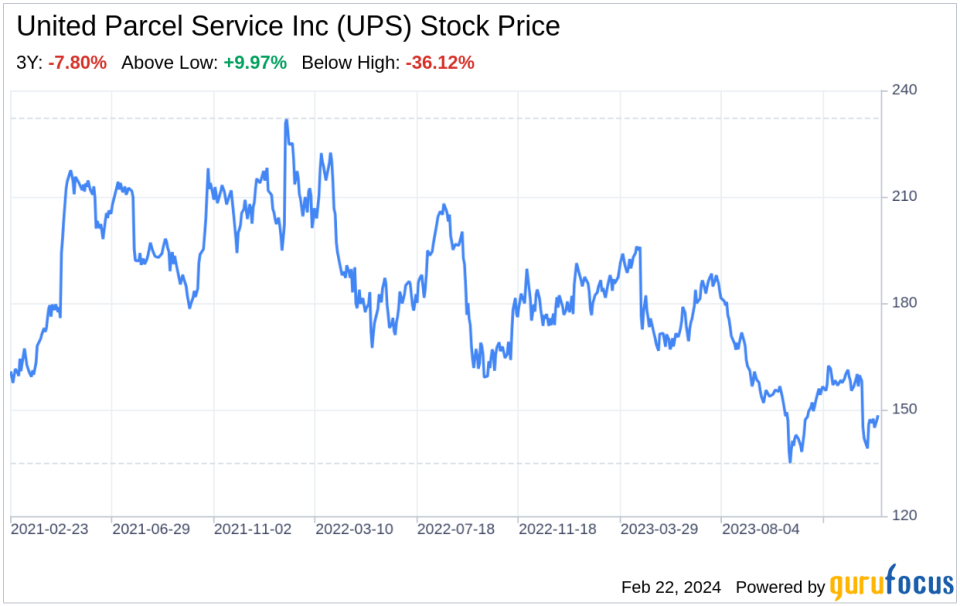Decoding United Parcel Service Inc (UPS): A Strategic SWOT Insight
UPS's extensive global network and brand equity position it as a leader in the logistics industry.
Technological advancements and strategic acquisitions offer significant growth opportunities.
Dependence on a single customer, Amazon, and stringent regulations pose potential threats.
Financial strength and strategic initiatives indicate a positive outlook for UPS.
United Parcel Service Inc. (NYSE:UPS), the world's largest parcel delivery company, filed its 10-K on February 20, 2024, revealing a comprehensive overview of its operations and financial health. With a fleet of over 500 planes and 100,000 vehicles, UPS delivered an average of 22.3 million packages per day in 2023, generating a total revenue of $91.0 billion. The company's domestic U.S. package operations accounted for approximately 64% of this revenue, with international package operations contributing 20%, and the remainder stemming from air and ocean freight forwarding, truckload brokerage, and contract logistics. This SWOT analysis delves into the strengths, weaknesses, opportunities, and threats as presented in the SEC filing, providing investors with a detailed perspective on UPS's current position and future prospects.

Strengths
Global Smart Logistics Network: UPS's integrated global air and ground network is unparalleled in the industry, offering a comprehensive range of package services. This network's efficiency is enhanced by cutting-edge technologies such as RFID-enabled Smart Package and Smart Facility technology, which optimize asset utilization and provide end-to-end shipment visibility. In 2023, UPS's global reach extended to over 200 countries and territories, serving 1.6 million shipping customers and delivering 5.7 billion packages throughout the year.
Brand Equity and Customer Relationships: UPS has cultivated a strong brand reputation for quality, reliability, and innovation. The company's distinctive brown delivery trucks and the professionalism of its drivers contribute significantly to its brand image. Long-term customer relationships are a cornerstone of UPS's business model, with value-added services fostering customer retention and growth. Notably, one customer, Amazon.com, Inc., accounted for 11.8% of UPS's consolidated revenues in 2023, underscoring the importance of such relationships.
Financial Strength: UPS's financial robustness allows for strategic investments in technology, acquisitions, and infrastructure, which are crucial for growth and shareholder value. The company's strong credit rating and substantial revenue provide the flexibility needed to navigate the dynamic logistics market.
Weaknesses
Dependence on Key Customers: UPS's significant revenue dependence on a single customer, Amazon, which represented 11.8% of its 2023 revenues, poses a risk. Any changes in this relationship could materially affect UPS's financial performance. Diversifying its customer base is essential to mitigate this vulnerability.
Operational Expense Reclassification: In 2023, UPS reclassified certain operating expenses, which, while not impacting reported revenue or net income, indicates ongoing adjustments to align with operational management. This reclassification reflects the company's efforts to optimize its cost structure, which is critical in the competitive logistics industry.
Regulatory Compliance Costs: As a global logistics provider, UPS is subject to stringent regulations across various jurisdictions. Compliance with these regulations may lead to increased operational costs, and any non-compliance could result in fines or operational restrictions, impacting profitability.
Opportunities
Technological Advancements: UPS continues to invest in digital tools and capabilities that integrate its services with customer distribution channels, enhancing efficiency and customer service. The acquisition of Happy Returns in the fourth quarter of 2023 exemplifies UPS's commitment to innovation, offering end-to-end return services that cater to the growing e-commerce market.
Expansion of Service Portfolio: UPS's broad portfolio of services, including its Supply Chain Solutions segment, presents opportunities for growth beyond traditional package delivery. The company's ability to offer integrated solutions across the entire supply chain is a competitive advantage that can drive business expansion.
Global E-commerce Growth: The continued rise of e-commerce globally is a significant opportunity for UPS. The company's extensive network and efficient returns services are well-positioned to capitalize on the increasing demand for reliable delivery and logistics solutions.
Threats
Competitive Landscape: UPS operates in a highly competitive industry with many local, regional, national, and international logistics providers. The company must continuously innovate and enhance its service offerings to maintain its market position and address competitive pressures.
Regulatory Changes: Changes in laws and regulations, particularly those related to air operations, can have a substantial impact on UPS's business. The company must navigate these changes carefully to avoid increased costs or operational challenges.
Economic Fluctuations: As a global entity, UPS is susceptible to economic downturns and geopolitical events that can disrupt trade and affect shipping volumes. The company must remain agile and responsive to these external factors to mitigate potential adverse effects on its operations.
In conclusion, United Parcel Service Inc. (NYSE:UPS) exhibits a robust set of strengths, including a vast global network, strong brand equity, and financial stability, which position it favorably in the logistics industry. However, it must address weaknesses such as customer concentration and regulatory compliance costs to sustain its competitive edge. UPS's opportunities lie in technological advancements and the burgeoning e-commerce sector, while it must remain vigilant of threats from intense competition, regulatory changes, and economic uncertainties. Overall, UPS's strategic initiatives and forward-looking strategies suggest a positive trajectory for the company's future growth and market leadership.
This article, generated by GuruFocus, is designed to provide general insights and is not tailored financial advice. Our commentary is rooted in historical data and analyst projections, utilizing an impartial methodology, and is not intended to serve as specific investment guidance. It does not formulate a recommendation to purchase or divest any stock and does not consider individual investment objectives or financial circumstances. Our objective is to deliver long-term, fundamental data-driven analysis. Be aware that our analysis might not incorporate the most recent, price-sensitive company announcements or qualitative information. GuruFocus holds no position in the stocks mentioned herein.
This article first appeared on GuruFocus.
